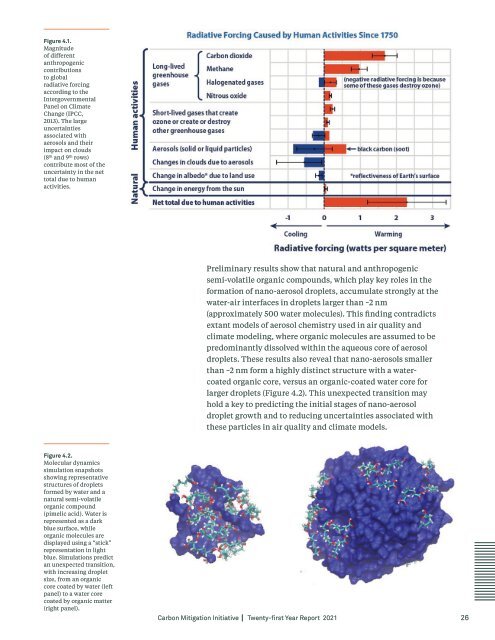CMI Annual Report 2021
You also want an ePaper? Increase the reach of your titles
YUMPU automatically turns print PDFs into web optimized ePapers that Google loves.
Figure 4.1.<br />
Magnitude<br />
of different<br />
anthropogenic<br />
contributions<br />
to global<br />
radiative forcing<br />
according to the<br />
Intergovernmental<br />
Panel on Climate<br />
Change (IPCC,<br />
2013). The large<br />
uncertainties<br />
associated with<br />
aerosols and their<br />
impact on clouds<br />
(8 th and 9 th rows)<br />
contribute most of the<br />
uncertainty in the net<br />
total due to human<br />
activities.<br />
Preliminary results show that natural and anthropogenic<br />
semi-volatile organic compounds, which play key roles in the<br />
formation of nano-aerosol droplets, accumulate strongly at the<br />
water-air interfaces in droplets larger than ~2 nm<br />
(approximately 500 water molecules). This finding contradicts<br />
extant models of aerosol chemistry used in air quality and<br />
climate modeling, where organic molecules are assumed to be<br />
predominantly dissolved within the aqueous core of aerosol<br />
droplets. These results also reveal that nano-aerosols smaller<br />
than ~2 nm form a highly distinct structure with a watercoated<br />
organic core, versus an organic-coated water core for<br />
larger droplets (Figure 4.2). This unexpected transition may<br />
hold a key to predicting the initial stages of nano-aerosol<br />
droplet growth and to reducing uncertainties associated with<br />
these particles in air quality and climate models.<br />
Figure 4.2.<br />
Molecular dynamics<br />
simulation snapshots<br />
showing representative<br />
structures of droplets<br />
formed by water and a<br />
natural semi-volatile<br />
organic compound<br />
(pimelic acid). Water is<br />
represented as a dark<br />
blue surface, while<br />
organic molecules are<br />
displayed using a “stick”<br />
representation in light<br />
blue. Simulations predict<br />
an unexpected transition,<br />
with increasing droplet<br />
size, from an organic<br />
core coated by water (left<br />
panel) to a water core<br />
coated by organic matter<br />
(right panel).<br />
Carbon Mitigation Initiative Twenty-first Year <strong>Report</strong> <strong>2021</strong><br />
26
















